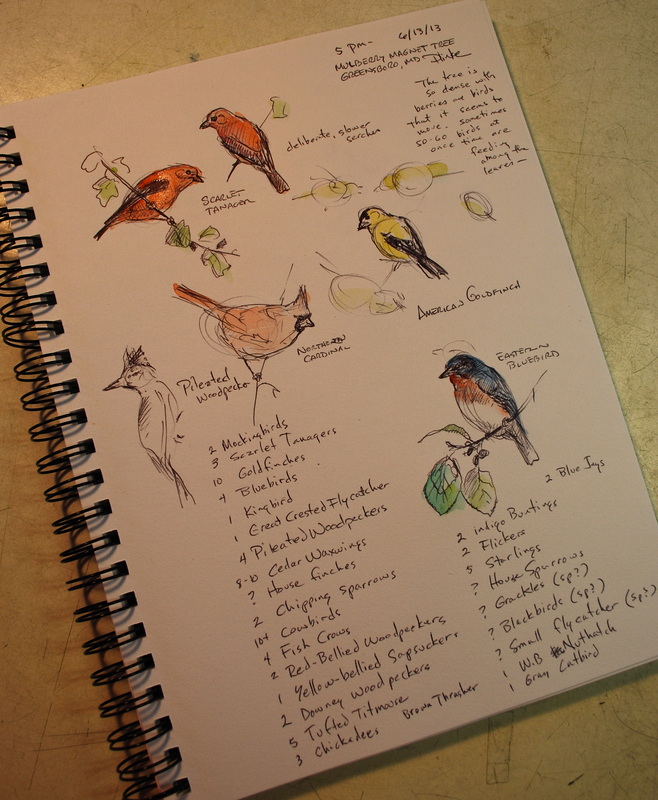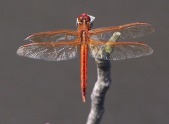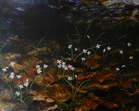| Kurt Plinke, Artist and Naturalist |
Between the Waters
life, Art and The Nature of things Between the Atlantic and the Chesapeake
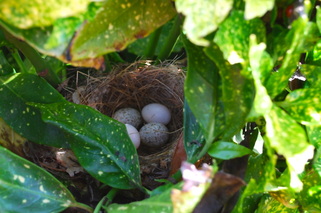 We have an Aucuba in our back yard, a handsome speckled shrub. Standing about six feet tall, this particular Aucuba, or Spotted Laurel, has begun to encroach upon the path leading to a gated garden. As my wife and I looked at how to cut it back, she noticed a nest in the shrub, about four feet off of the ground. (she always spots that sort of thing before I do) There were eggs in it, so trimming the shrub was set on hold. I put the loppers away, and we went to examine the nest more closely. I could tell from the shape of the nest that it was made by a house finch. I had seen many of these nests in our yard... the house finch, with it's raspberry-colored head, is one of the more common birds near the house. We peeked into the nest, and saw that there were two pale, almost-white eggs in the nest, and two eggs, dotted with brown flecks. A third pale egg was wedged into a branch just below the nest. I hate when I see this in a nest. I shouldn't, but I do. I knew right away that one of the Cowbirds we see at the feeders had been there, and had laid several eggs in the House Finch's nest. The Cowbird had also probably pushed the one finch egg out of the nest, as well. I get mad when I see this, because Cowbirds do this to so many native songbirds. There are some species of birds that are seriously parasitized by Cowbirds. That's why I get mad. It doesn't seem fair. On the other hand, Cowbirds are also a native songbird. They even actually have a pretty song, sort of a liquid tumbling song. If they weren't such parasites, they'de be pretty. 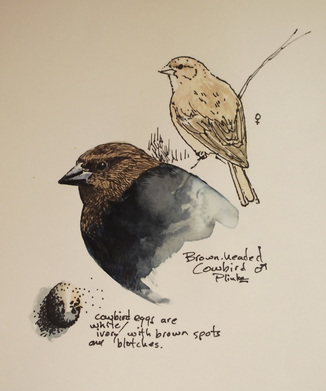 Brown-headed Cowbirds, Molothrus ater, are, as I said earlier, native to North America. They frequent open land, and their range has spread from the prairies as we have cleared land and made the eastern United States more open. Cowbirds are a species of blackbird, relatively small, but stocky, with a large head. The brown-headed Cowbird male is dark, nearly black, with a brownish head and nape. The female is lighter, resembling a large House Sparrow, light tan and brown, sometimes with very pale streaks on the back. It is the female Cowbird that waits to place her eggs in the nests of other birds. According to the Cornell Lab of Ornithology, All About Birds, (http://www.allaboutbirds.org/guide/brown-headed_cowbird/id), different Cowbird females tend to lay eggs in only one species of bird. Some might chose a Yellow Warbler, while the one in my back yard choses to lay eggs in the nests of House Finches. Not all Cowbirds are so choosy, it appears that a few will lay their eggs in almost any nest. Sometimes, the female Cowbird pushes the nesting species' eggs out of the nest as she replaces them with her own. Other times, the young cowbird, which hatches quickly, pushes the other eggs out. In either case, the result is that the single remaining young is a Cowbird. The nesting birds feed the young cowbird as though it is their own. The female Cowbird is long-gone, and does not have any association with her young. Seeing small songbird, like a Yellowthroat or Chipping Sparrow raising a baby bird that is twice the size of the "parents" can seem almost comical, even though it is, at the same time, sad. Some species, such as the Kirkland's Warbler, are so seriously effected by Cowbirds, that they are endangered. Some birds, like the Yellow Warbler, differentiate between the eggs, and build a new nest on top of their old one, trapping the cowbird eggs deep beneath the new nest. Yellow Warbler nests sometimes are a stack of nests, one on top of the other, each containing cowbird eggs that will never hatch. House finches seem to be among the large group of birds that raise the cowbird young as their own, although I have discovered several cowbird eggs under the finch nest since first finding this particular nesting site. It may be that the female House Finch pushed out the uninvited eggs. According to Cornell, Cowbirds sometimes return to the nest, and finding their eggs gone, destroy the nest altogether. Despite the risk to the nest by an angry Cowbird, I want to intervene. I want to remove the cowbird eggs myself, helping out the finch family in my yard. So far I am refraining, allowing nature to take it's course. It will be interesting to see what happens.
0 Comments
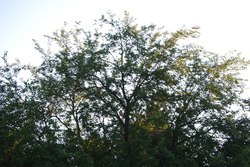 my magnet tree. my magnet tree. What the heck is a Magnet Tree? I have one in my yard. It's a red mulberry tree that attracts birds by the score this time of year. Early in the morning, just after sunrise, there doesn't seem to be a twig on the entire tree that isn't dripping with birds. Mulberries, plump and ripe, hang in clumps from every branch. As I walk past the tree on the way to my truck, I must walk through a dense carpet of berries that cover the ground. Fermenting among the grass, it reminds me of young wine. Not good wine, but still... Not all magnet trees are mulberries. Some are nut trees, or maple trees, or any other tree that bears fruit. I've never heard anyone else call these special trees magnet trees, but the name fits. These lone trees seem to draw birds from all over as they feast on the bounty of the magnet tree. 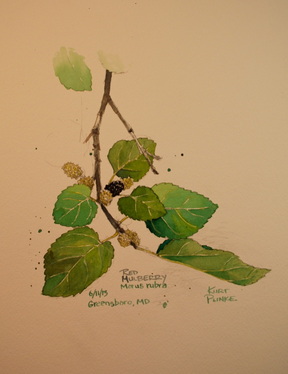 My magnet tree stands by itself, but not far from a dense wood. As soon as the snow melts every year, I begin thinking about my tree. I watch as the leaves unfurl, and then as the fruit begins to form. Each berry starts as a hard white little mass. Beginning in late May, the berries begin to swell and turn first pale green, then red before becoming succulent, ripe purple fruit. This particular mulberry tree hangs over our parking lot, and stands about forty-five feet tall. As I pull my truck under the tree in spring, I know that soon I won't be able to park there. As the berries ripen, they fall like rain from the canopy, leaving large purple stains anywhere they land. I don't mind losing my parking lot each June, though. Because as the berries ripen, the birds arrive. First a woodpecker or two, then a lone robin appears. Within days, the tree is a cacophony of sound. Flapping wings, warning calls and chirps of delight fill the air. Behind it all, the sound of berries falling to the ground is a constant, like rain dripping from a roof on a dewy morning. After a few days, the buzzing of all sorts of insects also join the bird sounds. Bumble bees, wasps, yellow jackets, hornets and all sorts of buzzing creatures are attracted to the fallen fruit. Butterflies by the scores flutter about the branches, sipping sweetness from the ripening bounty. My main interest, though, is always the birds. I sit outside the studio, drawing them quickly as they land, gorge on berries, then fling themselves heavily into the sky. Sometimes, they eat too many over-ripe fruit. Then they tilt crazily, sitting sideways on the ground, looking like little feathered winos who've gulped too much from a paper bag. My favorite birds among the many visitors are the bright birds of summer... orioles, tanagers and goldfinches. We get both Baltimore Orioles and Orchard Orioles visiting the tree. Sometimes, there may be a dozen orioles in the tree at one time. Often, half a dozen tanagers can be seen at once near the tip-top of the tree. The bright flashes of screaming red and black startle my eye as the male tanagers move deliberately among the leaves. Pileated woodpeckers are among the flashiest birds that vist the tree. We are lucky enough to have three pairs nest nearby, and at times, six of the big birds are in the tree at one time, chasing each other with wide, flashing wingbeats. Sometimes, there are up to five species of woodpeckers in the tree at once. Along with the big pileateds, we have regular visits from red-bellies, downey and hairy woodpeckers as well as yellow-bellied sapsuckers. I love my magnet tree. I wait for it to fruit every year, looking forward to the myriad of species that it draws to my yard. I hope you can find your own magnet tree, and enjoy it as much as I do mine. |
What's News?Kurt Plinke: About Life, Art and the Nature of Things on the Eastern ShoreI write about things I've noticed, places I've been, plans I've made and paintings I've finished or am thinking about. Archives
February 2020
See recent naturalist observations I have posted on iNaturalist:
|
|
Sewell Mills Studio & Gallery
14210 Draper's Mill Road Greensboro, MD 21639 (410) 200-1743 [email protected] |
Rights to all images on this website, created by Kurt Plinke, remain the property of Kurt Plinke. Copying or use of these images is permissible only following written permission from Kurt Plinke. To use images for any purpose, contact [email protected] for permission.
